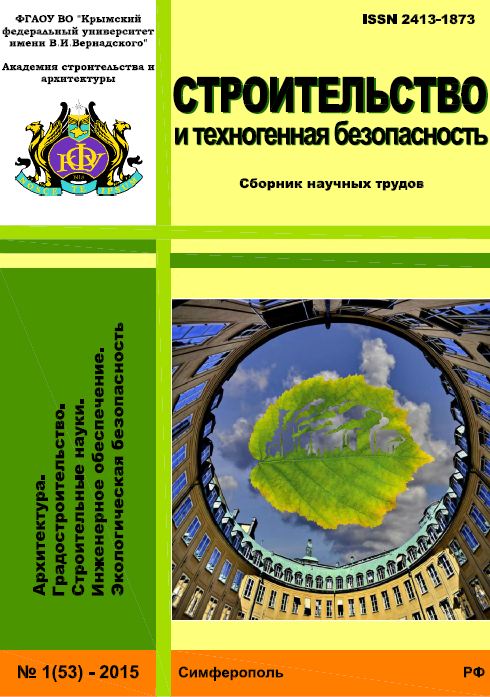Volgograd, Volgograd, Russian Federation
Russian Federation
Abstract. The existing approaches to decision-making in construction have two significant drawbacks. Firstly, they allow us to calculate the effectiveness of the options under consideration only for the object construction phase, without giving an idea of the decisions effectiveness taken at other life cycle stages. Secondly, the absence of an environmental safety criterion for a particular technology in the model reduces its universality and the adequacy of the decisions taken. The article proposes a new approach to management decision-making in construction as to the management of a capital construction object life cycle. A methodology has been developed for making optimal decisions on life cycle management, taking into account the criterion of atmospheric air dust pollution. In order to build the methodology, a block diagram of the formation of dust emissions into the atmosphere from temporary pollution sources at various stages was developed. The dust pollution values for works performed at various life cycle stages of a capital construction object were obtained experimentally. Based on the data obtained, the values of the given optimization criterion are determined for choosing the optimal solution for life cycle management, taking into account the criterion of atmospheric air dust pollution. Unlike the existing ones, the developed methodology allows, firstly, to calculate the effectiveness of the options under consideration not only for the construction stage, but also for the entire object life cycle. Secondly, the model introduces a criterion of environmental safety of the control solutions under consideration, quantified by the degree of dust pollution of atmospheric air. Subject of research: The processes of atmospheric air dust pollution when performing work at various stages of the capital construction object life cycle. Materials and methods: Theoretical and experimental methods for determining the concentration of dust pollution using the Ecologist program, based on the results of field dust pollution measurements and aerosol dispersed composition analysis. Results: A methodology for making optimal decisions on managing the capital construction object life cycle has been developed, including 5 stages. 1. Identification of work types that cause atmospheric air dust pollution. 2. Determination of fine dust concentration from each type of work. 3. Determination of the atmospheric air pollution indicator total value for the implementation of all control solutions (technologies) variants and for all capital construction object life cycle stages according to the proposed model. 4. Determination of given optimization criterion values for the implementation of all control solutions (technologies) variants and for all life cycle stages according to the proposed expression. 5. Selection of the control solution (technology) with the lowest given optimization criterion value. Conclusions: As a result of theoretical and practical research, a methodology has been created that allows, firstly, to calculate the effectiveness of the options under consideration not only for the construction stage, but also for the entire object life cycle. Secondly, the model introduces a criterion of environmental safety of the control solutions under consideration, quantified by the atmospheric air dust pollution degree.
dust pollution, life cycle, capital construction object
1. Kabanov V.N. Technical criterion for choosing an excavator for excavation development // Engineering Bulletin of the Don. 2021. No.1 (73). – Pp. 298-306.
2. Golubova O.S. Indicators of economic efficiency of construction works = Indicators of economic efficiency of construction works // Ekonomicheskaya nauka segodnya: collection of scientific articles. Belarusian National Technical University. – Minsk: BNTU, 2018. – Issue 8. – Pp. 130-138.
3. Dos Santos J.E., Galhardo C.X. Innovations in the Civil Construction Sector Provided by Information Technologies // Revista Geintec-Gestao Inovacao E Tecnologias. – Vol. 9. – Issue 4. – 2019. – P. 5131-5145. DOI:https://doi.org/10.7198/geintec.v9i4.1382.
4. Jin R.Y., Integrating BIM with building performance analysis in project life-cycle / R.Y. Jin, B.T. Zhong, L. Ma, A. Hashemi, L.Y. Ding // Automation In Construction. 2019. Vol. 106. Article Number: UNSP 102861. DOI:https://doi.org/10.1016/j.autcon.2019.102861.
5. Ma W.N., Comprehensive Performance Evaluation Method of Green Materials for Coastal Buildings Based on BIM / W.N. Ma, Y.D. Yin, G. Yang, Q. Li // Journal of Coastal Research. – Spec. Issue 93. – 2019. – P. 304-309. DOI:https://doi.org/10.2112/SI93-040.1.
6. Okakpu A. Exploring the environmental influence on BIM adoption for refurbishment project using structural equation modeling / A. Okakpu, A. Tookey, J. Ghaffarianhoseini, J. Haar // Architectural Engineering and Design Management. – 2019. – DOI:https://doi.org/10.1080/17452007.2019.1617671.
7. Shafique M., Rafiq M. An Overview of Construction Occupational Accidents in Hong Kong: A Recent Trend and Future Perspectives //Applied Sciences-Basel. – Vol. 4. – Issue 10. – 2019. – Article Number: 2069.
8. Shuang D. An experimental study of intrusion behaviors on construction sites: The role of age and gender / D. Shuang, L. Heng, M. Skitmore, Y. Qin // Safety Science. – Vol. 115. – 2019. – P. 425-434. DOI:https://doi.org/10.1016/j.ssci.2019.02.035.
9. Filippov A. A., Suleymanov I.F., Arslanov M.A. Theoretical foundations of an integrated approach to assessing the environmental hazard of motor transport in an urbanized area // Intelligence. Innovation. Investment. 2019. No. 1. Pp. 97-103. DOI:https://doi.org/10.25198/2077-7175-2019-1-97.
10. Kalyuzhina E.A. Investigation of dust emissions into the surrounding atmosphere and into the atmosphere of the working area during repair and construction works / E.A. Kalyuzhina, N.M. Sergina, K.A. Elfimov, A.B. Strelyaeva // Bulletin of Volgograd State University of Architecture and Civil Engineering. Series: Construction and Architecture. – 2020. – № 4(81). – Pp. 371-378.
11. Luo Q. Dust dispersion patterns during construction processes: A multi-process simulation study / Q. Luo, L. Huang, Y. Liu, X. Xue, F. Zhou, J. Hua // Sustainability 2021, 13, 8451.
12. Glinyanova I.Yu., Asanova N.V. Investigation of the amount of fine dust and its chemical composition in the residential area of settlements from the standpoint of environmental safety of construction industry enterprises [Electronic resource] // Construction and technogenic safety. — 2021. — № 23(75). — P. 89-100.
13. Burlachenko O.V., Burlachenko A.O., Oganesyan O.V. Choosing optimal technological solutions in conditions of dense urban development based on BIM technologies // Bulletin of Volgograd State University of Architecture and Civil Engineering. Ser.: Construction and Architecture. – 2020. – Issue 1 (78). – Pp. 329-336.
14. Azarov V.N., Burlachenko A.O. Organization of construction production taking into account the environmental safety of the decisions taken // Biosphere compatibility: person, region, technology. – 2023. – Issue 1 (41). – Pp. 76-83.
15. Azarov V. N., Elfimov K. A., Davudov R. I. [et al.]. On the use of random functions for the analysis of dust pollution of pedestrian zones // Bulletin of the Volgograd State University of Architecture and Civil Engineering. Series: Construction and Architecture. – 2022. – № 2(87). – Pp. 171-177.







